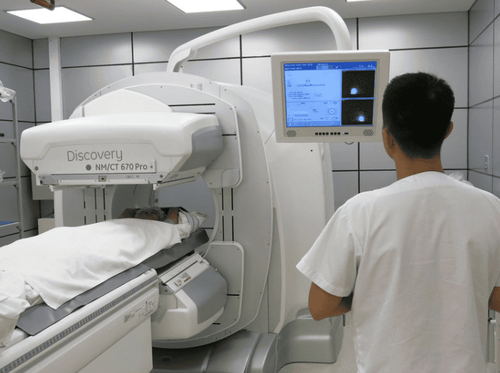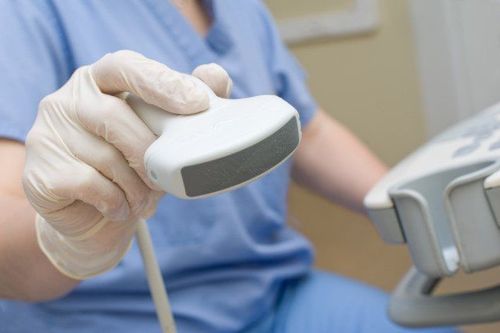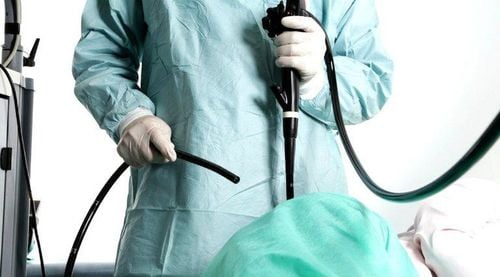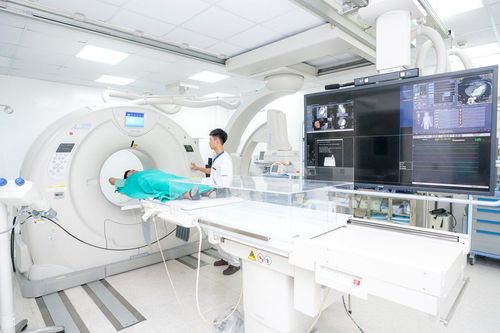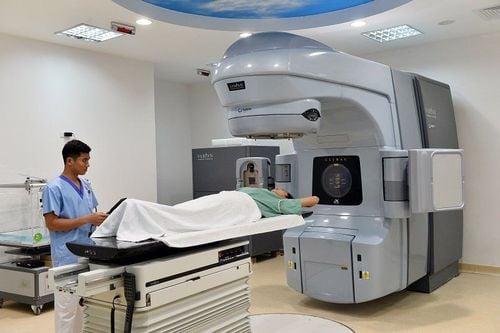This is an automatically translated article.
The article is professionally consulted by Master, Doctor Nguyen Quang Duc - Doctor of Nuclear Medicine - Department of Diagnostic Imaging and Nuclear Medicine - Vinmec Times City International General Hospital.Today, nuclear medicine plays an important role in the diagnosis and treatment of cancer diseases. Tumor radiography is a diagnostic technique that uses radioisotopes to detect tumors, thereby determining the stage of the disease as well as searching for metastases, assessing response to treatment and the possibility of recurrence.
1. What is tumor radiographic imaging?
Tumor radiography is a method that uses radioactive isotopes to image and detect tumors even when they are just forming or in the growing stage. Tumor radiography is a modern technique to help diagnose and detect cancer early, thereby assessing and determining the stage of the disease, and promptly detecting metastatic cancer. Tumor radiography also helps monitor the response in the treatment of cancer diseases, distinguishing between recurrent tumors and inflammatory and fibrous tissues after treatment...There are 4 types of radiopharmaceuticals available. used for tumor imaging, that is: non-tumour-focused radiopharmaceuticals, tumor-specific radiopharmaceuticals, radiopharmaceuticals involved in tumor metabolism, and radiopharmaceuticals that specifically bind to tumor density.
Using tumor radiopharmaceuticals for imaging based on the following general characteristics of tumors:
Tumor organization has inflammatory-like properties such as increased perfusion, proliferation of microvasculature, increased permeability, Increased cell metabolism leads to increased energy expenditure. The density of tumor cells is increased compared to normal cells, in addition, the tumor also develops some more specific antigens.
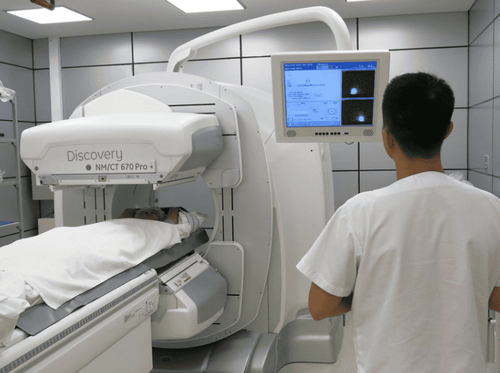
2. Classification of tumor radiographs
Tumor radiographic imaging is divided into two types:Non-specific radiopharmaceutical imaging. Imaging with specific radiopharmaceuticals. 2.1 Non-specific tumor radiopharmaceutical imaging Non-specific radiopharmaceutical imaging includes negative and positive contrast imaging.
2.1.1 Negative contrast imaging of the tumor Based on the negative contrast principle, it means that the tumor is an area with less radioactivity, and radioisotopes are distributed only in those areas. The tissue is healthy, so on the radiograph of the tumor obtained, the tumor is a defect or has a reduced radioactivity compared to the surrounding tissues.
The cause of this contrast is that the cancer cells change the vascular distribution, metabolism and cell necrosis, thereby reducing or completely losing the ability to absorb radiation.
Negative contrast radiography usually uses iodine radioisotopes to image and detect thyroid cancer and liver cancer (due to poor capture or inability of cancer cells). radioactive iodine capture).
2.1.2 Radiographic imaging of the tumor according to the positive contrast principle Based on the positive contrast principle, it means that the tumor is an area with a higher concentration of radiation than the surrounding tissues, so on Radiographic image of the tumor, the lesion is a hot area.
The cause of this contrast is that cancer cells destroy surrounding tissues, so that radioactive substances can enter the damaged area and concentrate there.
In brain tumors, tumor cells damage the blood-brain barrier and facilitate the entry of radiopharmaceuticals into the tumour. In bone cancer, tumor cells destroy bone and regenerate the surrounding area of bone destruction, so radiopharmaceuticals are more concentrated.
Positive contrast tumor radiographs use radioisotopes of 99mTc colloid to detect liver cancer metastasis, 99mTc - diphosphonate to detect bone metastases, and 99mTc - DMSA to diagnose cancer medullary thyroid cancer, soft tissue tumor lesions, ...
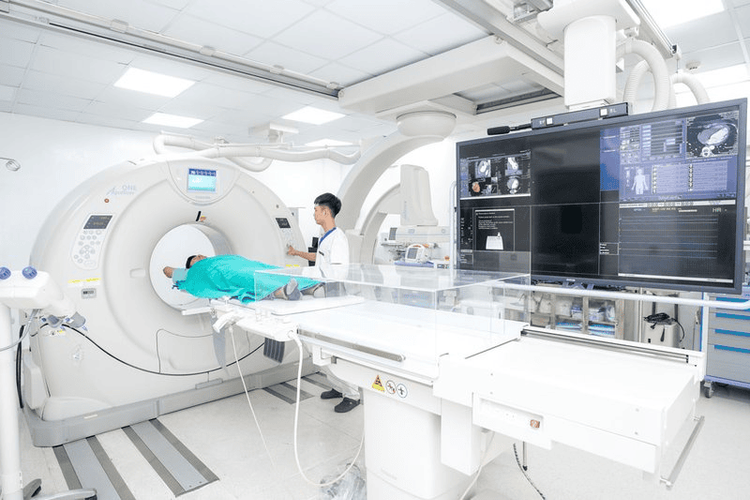
2.2.1 Tumor radiographic imaging with gallium (67Ga) 67Ga is used for radiographic imaging of tumors in cases of lymphoma, lung cancer, liver cancer, melanoma and cancer. some other tumor diseases such as neuroma and metastasis of neuroma, parathyroid cancer, bone cancer, ...
Hodgkin's disease: 67Ga imaging can help early diagnosis and identify necessary lymph nodes biopsies, and at the same time help detect pathological foci located in the mediastinum. Non-Hodgkin Lymphoma: Radiographic imaging of tumors with 67Ga is mainly used to monitor the response and progression of the disease after treatment and to assess the possibility of recurrence. Lung cancer: 67Ga imaging helps to detect primary lung cancer in the mediastinum and hilum. Note when taking radiographs of lung cancer that in addition to the tumor, there are a number of other normal healthy tissue structures that are also capable of capturing radioactive 67Ga such as sternum, bronchioles, ... Besides, When using 67Ga for radiographic imaging, it is also necessary to differentiate with some benign lung diseases such as tuberculosis, pneumonia, empyema, .... Liver cancer: Liver and liver parenchymal cells capable of capturing 67Ga radiation. However, in order to clearly identify liver cancer, 99mTc - sulfur colloid should be used first for radiographic imaging of liver cancer because this radiopharmaceutical helps detect liver tumors. On radiographic imaging of the tumor, liver cancer is a defect because radiation cannot enter. But 99mTc-sulfur colloid did not distinguish tumors from other non-tumor structures or dense cirrhotic nodules. Therefore, it is necessary to scan the liver with 9mTc - sulfur colloid first and then use 67Ga. Melanoma: 67Ga tomography helps diagnose melanoma, especially when the cancer metastasizes to bone, ... Other cancers: 67Ga can be used for recording Tumor radiographs help detect and differentiate parathyroid carcinoma from parathyroid hyperplasia. In addition, this radiopharmaceutical also helps diagnose primary or metastatic adrenocortical carcinoma; diagnose primary penile cancer (squamous cell) and metastasis; primary bone cancer, ... 2.2.2 Tumor radiographic imaging with 201Tl and 99mTc-MIBI 201Tl is used to radiographically record tumors in cases of thyroid cancer, brain cancer, and bone cancer. (Sarcoma), and a number of other cancers such as bronchial cancer, breast cancer, esophageal cancer, ...
Thyroid cancer: 201Tl has the ability to penetrate all types of thyroid tumors including neoplasms. cysts, myeloma, and papillomas. Brain cancer: 201Tl intravenously and radiograph the tumor after about 5 - 30 minutes. Bone Cancer (Sarcoma): 201Tl is used to differentiate between benign or malignant bone lesions and soft tissue. The percentage of radiopharmaceuticals absorbed in malignant lesions is higher than in benign lesions. Similar to the radioisotope 201Tl, 99mTc-MIBI is also a non-specific radiopharmaceutical used for radiological imaging of tumors in thyroid cancer, breast cancer, lung cancer, liver cancer, and cancer. colon , pancreatic cancer , bladder cancer .
In which, the 99mTc-MIBI SPECT imaging technique plays an important role in helping diagnose, determine the stage of lung cancer, and also help predict chemotherapy response and assess the possibility of recurrence after radiation therapy. and surgical treatment of lung cancer.
2.2.3 Tumor radiographic imaging with cancer antibodies It is possible to use tumor radiolabelled monoclonal antibodies to detect many cancer diseases such as malignant melanoma, lung cancer small cell, colorectal cancer, ovarian cancer.
2.2.4 Tumor radiographic imaging by binding specifically to tumor receptor density Tumor radiopharmaceuticals used for imaging to bind to tumor receptor density must satisfy the following conditions:
Focuses specifically on tumor cell receptor density. Low concentration on the receptor density of normal cells. At very low concentrations, there is still the ability to interact with high density of tumor receptors. Radioimaging of tumors by binding specifically to the density of tumor receptors is used to detect several types such as stomach cancer, bowel cancer, pancreatic cancer, liver cancer (hepatoma), cancer. small cell lung, breast and pituitary cancer.
2.2.5 Tumor radiographic imaging by 131I- MIBG 131I- MIBG is used to detect cancers that have metastasized to bone or soft tissue such as medullary thyroid cancer. In addition to diagnostic applications, 131I-MIBG is also used in the treatment of foci of metastatic cancer.
2.2.6 Tumor radiograph with 99mTc-SESTAMIBI 99mTc-SESTAMIBI is used for radiographic imaging of benign tumors originating from the epithelial cells (Adenoma) of the parathyroid gland. With a normal thyroid gland, the radiopharmaceuticals will be excreted quickly, with benign tumors of the thyroid and parathyroid glands, the radiation will persist longer.
99mTc-SESTAMIBI is considered an important substance for imaging and detecting thyroid cancer.
Tumor radiography includes 2 types: using non-specific radiopharmaceuticals and specialized radiopharmaceuticals for cancer. This method helps to detect many damaged areas such as liver, lung, bone, ...
Early cancer screening is considered a perfect measure in timely detection and treatment of all types of cancer. Reduce treatment costs and especially reduce patient mortality. Vinmec International General Hospital always deploys and introduces to customers HIGH-TECH CANCER EXAMINATION AND SCREENING PACKAGE for gene testing, imaging diagnostics, biomarker testing for early tumor detection. Vinmec International General Hospital has many early cancer screening packages. Only one gene test can assess the risk of 16 common cancers in both men and women (lung cancer, colon cancer) rectal cancer, breast cancer, pancreatic cancer, cervical cancer, stomach cancer, prostate cancer, ....)
Early detection of early signs of cancer through diagnosis imaging, endoscopy and ultrasound. The examination operation is simple, careful and accurate. A team of well-trained specialists, especially in oncology, is capable of handling cancer cases. With equipped facilities, advanced and modern medical equipment and a team of doctors with deep expertise and experience. At Vinmec, the examination process becomes quick with accurate results, saving costs and time for patients.
If you have a need for consultation and examination at Vinmec Hospitals under the nationwide health system, please book an appointment on the website for service.
Please dial HOTLINE for more information or register for an appointment HERE. Download MyVinmec app to make appointments faster and to manage your bookings easily.





